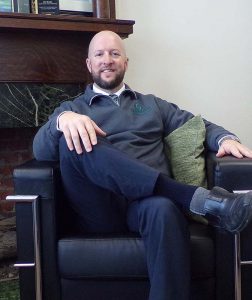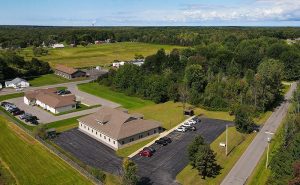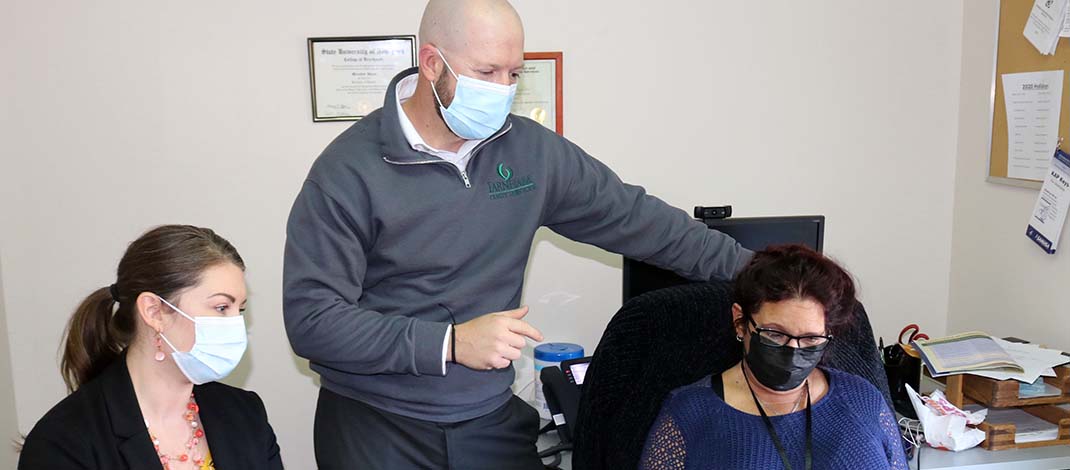Oswego-based nonprofit celebrating 50 years of helping people conquer addiction
Farnham Family Services is a NYS licensed, private, nonprofit organization. It helps people with substance use and behavioral health disorders, providing high quality, recovery-oriented outpatient treatment and prevention services that are available to all residents of Oswego and surrounding counties.
The executive director aims to continue to build upon the success of his predecessor.

“I came over in 2015, took over for Jean Unger. She was an absolute amazing leader,” Eric Bresee said. “It will be six years on Nov. 30. I was actually on the Farnham board for two years. As (Unger) was getting ready to leave, she said that I should consider applying for this position. I considered myself an OCO lifer; I loved working at OCO [Oswego County Opportunities]. It’s a great company. I had a lot of great opportunities there. I didn’t think I was ever going to leave. But I started thinking about this opportunity and coming over here. I ended up getting offered the job and ultimately taking it.”
For more than a half century, Farnham has provided Oswego County with solutions to the problems created by substance abuse.
Since its inception as a crisis center in an abandoned dormitory on the eastern edge of the SUNY Oswego campus, Farnham has evolved by adding and adapting services to meet the ever-changing needs of those in Oswego County.
Services such as individualized and group counseling, continuing care, parenting education, medication assisted treatment, jail-based services, additional vocational supports and evidence-based programs are helping hundreds of individuals.
Opioid crisis
“When I came over, we were in the throes of the opioid epidemic. Starting to ramp up where the treatment agency was starting to see more folks presenting with opioid use disorder than alcohol use disorder for the first time ever,” Bresee said.
It’s still a problem, he said, adding, there are still a lot of overdoses.
“Overdoses are up in ‘20, ’21. Opioids are still an issue,” he said. “We realized that we really had to do something different to help; reach and serve this population of people who were struggling with opioid addiction. So, we set out to do the opioid treatment program. It’s a federally approved clinic that is able to offer all three FDA-approved medications for opioid use disorders.”
The three medications for treating opioid substance abuse disorder are methadone, buprenorphine and naltrexone.
It’s not a one size fits all, Bresee explained. “You have to try a lot of different things with people to see what works.”
They have been expanding prevention services, school-based and community-based prevention, adding staff and buildings and school districts, education-based prevention as well as started offering peer support services, he said.
More services
“We are now offering services in Mexico and Pulaski at the former Harbor Lights Chemical Dependency Services locations,” Bresee said. “The addition of those sites allows for easier access to our services and increases our presence in the county.”
The boards of directors of Farnham and the County of Oswego Council on Alcoholism and Addictions (COCOAA) joined forces to form a more efficient and stronger organization to prevent and treat local substance abuse.
This effort was supported by a grant awarded from the Central New York Community Foundation and the Shineman Foundation. The New York Council on Nonprofits was engaged to provide professional facilitation, due diligence and legal support services to a joint Strategic Partnership Task Force of the boards.

“The treatment and prevention of substance use disorder in Oswego County continues to be a high priority. COCOAA and Farnham will bring the strengths of the two organizations together and unite to build one organization that has the capacity and resources to meet the needs of Oswego County,” Bresee said.
Bresee remained in his position. Penny Greene, executive director of COCOAA, is the associate executive director of the newly unified organization.
As it has been since the beginning, outpatient treatment peer support continues to be Farnham’s most in-demand service. It’s a combination of mentorship, crisis support, education, in-home and community-based services, and connecting patients to formal recovery supports.
“I don’t know if we’ve seen a huge trend in younger people [with addictions]. I feel like that’s been relatively stable; there is a need there. Here at Farnham, we primarily serve 24-44, that’s the big age range,” Bresee said. “A lot of those folks started having trouble when they were younger, but it didn’t emerge to be a big issue until they got older.”
Prevention is the smart investment, he said.
“If you can help people never get to the point where their (substance) use is impacting their day-to-day life, that’s great; you’ll have a healthier society, community,” he said.
Seeking help
“I would say, right now, for the first time ever, we have just about as many self-referrals as we do criminal justice referrals. If you go back several years, most the folks coming in our doors were coming in because the probation office, the parole office or a judge, their CPS worker … someone was basically saying, ‘You need to seek treatment’ in order to deal with whatever they had going on,” he added.
That started to shift a couple years ago.
“We started seeing more and more people coming in of their own volition. More and more folks are recognizing that they need help and are willing to come in and get help,” he said. “That’s a great trend. Hopefully that means the stigma is starting to reduce. We still have a lot of stigma, though. And you have a lot of folks who don’t see their use as a problem, even though they are having a lot of using issues associated with their life. If, for example, you ask a wife, she’d say he has a problem, but if you ask him, he’d say, it’s not a problem for me. You get a little bit of that. There is certainly some of that denial.”
Farnham needs to continue to evolve, to meet people where they’re at, the director noted.
“Telehealth. One good thing that COVID-19 gave us was a need to get to telehealth as soon as possible,” he said. “That’s working out well for a lot of folks who wouldn’t or couldn’t come into to the clinic.”
With addiction, there is no one kind of treatment and telehealth is the newest tool.
“It takes a toolbox full of strategies. Education, recovery, faith-based support, clinical intervention, medication, peer support,” Bresee said. “There are a lot of strategies and you have to have all the tools in your toolbox to be able to individualize the plan.
Stigma lingers
“There’s still a stigma. A lot of times I think people see it as a moral failing, they just don’t have the self control, don’t have the discipline. It’s misunderstood; it makes some people not seek help.
There’s a lot of judgment out there, especially with addiction.”
Farnham currently serves 697 individuals and operates three clinics. It has 90 employees.
Are they overworked?
“Yeah, especially now. A lot of jobs are hard to fill right now. It’s been challenging. For clients, we do a hybrid model in-person and virtual meetings. We’re doing some in-person groups, but they’re primarily virtual these days,” he explained. “There are a lot of people getting help [for substance abuse] but it’s not improving as much as we’d like. We have our opioid treatment program with more than 260 people. That’s a lot of people.”
The first in the county, Farnham’s opioid treatment program was established to combat what has been termed the “heroin epidemic.”
There are other problems facing the area. Alcohol use (on the rise due to COVID-19), opioid use, synthetics. “Those are scary because folks don’t quite know what they’re getting into. They are trying a drug, thinking it’s one thing and it’s something different. They’re ending up with psychosis from using these drugs,” he said. “Or maybe there’s fentanyl in it or cocaine. It’s scary when you don’t know what’s in it.”
It can be hard to understand why people turn to drugs or alcohol.
“It’s complicated. Oftentimes it is connected with mental health, depression, anxiety, not wanting to be in their current reality and needing to be someone else,” Bresee said. “They are trying to find ways to deal with trauma mental pain. Some people had surgery and were given pain pills and got addicted; there are a lot of those stories. Their doctor won’t write them prescriptions any more, so they turn to street drugs.”
For more information on Farnham Family Services visit: farnhaminc.org
Featured Image: Eric Bresee, executive director, with Shonna Brodhead (left), opioid treatment program senior therapist and Merceded Giacaz, counselor. Photo courtesy of John DeRousie, Custom Marketing Solutions
The Need for Farnham’s Services Remains Great
Farnham has always had an important role in serving Oswego County regarding substance use and prevention, according to two of the agency’s clinical leaders.
 “In the last few years, the need for these services has grown due to the increased numbers in people struggling with opiate use disorder and the COVID pandemic,” said Shonna Brodhead. “People are experiencing disconnection and grief and loss at higher rates in the last 18 months. People have lost jobs, have been unable to be with family/friends and social/religious communities due to quarantine or isolation and have lost medical services and childcare. Most people have experienced this disconnect and loss on some level in the last few years.”
“In the last few years, the need for these services has grown due to the increased numbers in people struggling with opiate use disorder and the COVID pandemic,” said Shonna Brodhead. “People are experiencing disconnection and grief and loss at higher rates in the last 18 months. People have lost jobs, have been unable to be with family/friends and social/religious communities due to quarantine or isolation and have lost medical services and childcare. Most people have experienced this disconnect and loss on some level in the last few years.”
Michael Labarbera agreed.
“Farnham’s importance to the community cannot be overstated. Farnham providing services to the substance use disorder population is saving lives every day,” he said. “Farnham continuing to expand in its programming from the outpatient and opioid treatment program to prevention services and home and community based services is helping the community by connecting with the community and letting them know we are here for them.”
Opioids ‘A Significant Concern’
The opioid epidemic remains “a significant concern for our community,” according to Eric Bresee, executive director of Farnham Family Services.
According to data, overdoses in Oswego County continue to increase with 130 non-fatal and 22 fatal overdoses plus 104 Narcan saves reported from Jan. 1 through Aug. 12, according to Shane LaVigne, high intensity drug trafficking area officer, at the Oswego County Prevention Coalition meetings.
Farnham Family Services opened Oswego County’s first opioid treatment program (OPT) to combat what has been termed the “heroin epidemic.” It is now serving a census of more than 250 individuals, Bresee said.
Per the Centers for Disease Control and Prevention “Heroin-related overdose deaths have more than quadrupled since 2010” and Oswego County has not been immune.
“The problem is multifaceted, no one source to blame,” Bresee said. “To combat the epidemic, providers are making life-saving medication more available. Emergency responders, health and human service professionals, community members, family members and even those struggling with addiction are being trained in opioid overdose reversal interventions (Narcan).”
The statistics on fatalities are sobering. Addiction to opiates also has negative effects on physical and mental health, family, work, school, criminal behavior, overall functioning and society.
Farnham’s OTP provides residents of Oswego and neighboring counties a potentially life-saving opportunity and has a positive impact on the greater Oswego community.
“We are working to reduce stigma and break down other barriers to accessing help,” Bresee said. “There are strict laws and monitoring systems for prescription as well.”
There are myriad contributing factors when it comes to addiction. Many people who have been prescribed pain medication don’t suffer from substance use disorder. For those who need help, Farnham’s OTP offers medication-assisted recovery services to individuals with opioid substance use disorder.
Farnham is now offering Suboxone in the outpatient clinic.
Suboxone contains a combination of buprenorphine and naloxone.
Buprenorphine is an opioid medication, sometimes called a narcotic. Naloxone blocks the effects of opioid medication, including pain relief or feelings of well-being that can lead to opioid abuse.
Clients must be admitted in to the outpatient clinic to receive services.
Farnham provides recovery oriented, strengths-based treatment services. Its person-centered philosophy provides the individualized approach identified as a best practice in addiction treatment.
Available services include, but not limited to: intensive and non-intensive outpatient services, group treatment counseling, dual diagnosis (substance use mental illness), adolescent services, family and couples counseling, services for any individual affected by another’s chemical use and recovery groups.
Farnham started conducting walk-in access for the Opioid Treatment Program.
“The best times to walk in for connection to the Opioid Treatment Programs are Monday-Thursday, in the morning. If people need help they should not wait; call or come in anytime during our regular business hours,” Bresee said.
Roots at SUNY Oswego
In December 1970, Carl Davis of the Psychological and Consultation Center of SUNY Oswego received a state education grant ($13,000) to train a core group of (20) counselors in drugs, counseling, first aid and legalities to assist with the drug problem on campus.
Beginning as a crisis center in the abandoned dormitory, Farnham Hall was owned by the college. Due to location, college administration exerted strong influence over operations. In June of 1971 the grant ended and Farnham Hall was closed. A small group of people incorporated as “Farnham Youth Development Center,” making them eligible for funding from county, state and federal sources.




